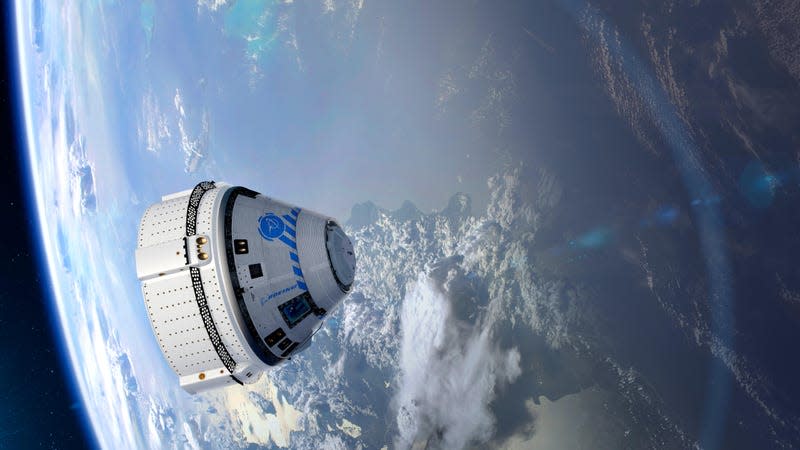Let's Look Back at Boeing's 10-Year Struggle to Launch Humans on Starliner

After more than a decade of delays and failures, Boeing is finally ready to launch its first crew of NASA astronauts to the International Space Station (ISS). Liftoff of the Starliner CST-100 spacecraft is scheduled for May 6—and it’s going to be a true nail-biter.
Boeing’s Crewed Flight Test (CFT) will carry NASA astronauts Butch Wilmore and Suni Williams to the ISS. The company’s Starliner spacecraft will ride atop the ULA (United Launch Alliance) Atlas V rocket, and launch is currently targeted for 10:34 p.m. ET on Monday from Cape Canaveral Space Force Station in Florida.
It’s been quite a journey to get to this point, and there’s a lot riding on the success of the upcoming test flight. Boeing has yet to meet the end of its $4.3 billionCommercial Crew Program contract with NASA. The company has fallen behind schedule and its last two test flights were marred by glitches. For its upcoming flight, Starliner will carry a crew for the first time after having recently resolved two major safety hazards discovered on the spacecraft.
In brief, it’s a hot mess. Let’s take a look back at how this inaugural crewed test flight came to be.
Boeing and SpaceX land NASA contracts
In 2014, NASA awarded Boeing and SpaceX contracts to provide launch services for crew and cargo to the ISS. NASA’s retirement of the Space Shuttle prompted the need for a new spaceship, and as NASA sought to wean itself off dependence on Russia’s Soyuz for crew transport, it invested heavily in developing partnerships with private aerospace companies. SpaceX’s Dragon spacecraft was the less expensive proposal at $2.6 billion, and yet the Elon Musk-led company has far outperformed its counterpart with eight crewed launches to date while Boeing still remains at zero.
At the time the contracts were handed out, Boeing was a much stronger contender in the aerospace industry. The CST-100 Starliner was first conceived in 2010, built on a long legacy of designing and building spacecraft for Apollo. The spacecraft measures 14.8 feet (4.5 meters) across and can fit up to seven astronauts.
A botched first flight, an investigation, and losses
Despite decades of aerospace experience, Boeing botched Starliner’s first test flight in 2019. Boeing’s OFT-1 mission, as it was called, managed to reach space, but a software automation glitch caused the spacecraft to burn excess fuel, preventing it from reaching the ISS. Starliner miscalculated its location in space due to a glitch caused by a faulty mission elapsed timer.
The spacecraft’s failure prompted an investigation by an independent NASA-Boeing review team, which resulted in a 28-month delay. The review of OFT-1 revealed numerous software issues and a need for more rigorous testing, prompting NASA to present Boeing with 80 recommendations. As a result, Boeing absorbed a $410 million charge to its earnings to cover an additional uncrewed test flight of its CST-100 Starliner.
Grounded by rust, and the second test
The second uncrewed test, OFT-2, was initially scheduled for August 2021 but was postponed multiple times due to valve issues in the spacecraft’s propulsion system. Specifically, the valves had accumulated rust as a result of Florida’s high humidity, leading to further delays and extensive inspections.
In May 2022, Boeing was finally ready to launch Orbital Flight Test-2 (OFT-2), a second uncrewed test flight of its Starliner spacecraft. OFT-2 suffered a few hiccups, including the failure of a thruster used for orbital maneuvering, but Starliner did manage to dock with the ISS and perform a successful return to Earth. OFT-2 set the stage for the first crewed test of Starliner.
Faulty parachutes and flammable tape
Boeing’s upcoming CFT will mark the third orbital test flight of the spacecraft overall, but the incessant stream of issues and ongoing delays made us feel like it was never going to happen. Boeing’s crewed Starliner launch was initially set for February 2023, then postponed to late April, and finally rescheduled for July 21, 2023. By that point, Boeing’s losses for the Starliner program had reached a staggering $1.1 billion.
A few weeks before liftoff, however, the company announced that it was standing down from the launch attempt to address newfound issues with the crew vehicle.
The first safety concern had to do with the load capacity of Starliner’s three parachutes, which are designed to safely land the crew vehicle. The failure load limit of the fabric sections on the parachutes was found to be lower than expected, meaning that, if one parachute failed, the remaining two would not be able to slow down the Starliner vehicle on its way down to land in New Mexico. The second concern involved hundreds of feet of protective tape used to cover the wiring harnesses inside the Starliner vehicle, which was discovered to be flammable. Engineers had to literally pull a mile of this flammable tape from the vehicle.
In March 2024, Boeing announced that it had resolved the safety issues and that its Starliner was all set to carry the astronauts to the ISS. For Boeing, the stakes are now higher than ever given the presence of a crew; a failure with Starliner this time around would be catastrophic.
“Do we expect it to go perfectly?” CFT astronaut Wilmore said during a press conference last week. “This is the first human flight of the spacecraft, I’m sure we’ll find things out. That’s why we do this.”
We’ll be anxiously awaiting the launch and subsequent docking of Starliner next week. We don’t expect a flawless mission but hope that any glitches will be minor and not jeopardize the safety of the crew.
For more spaceflight in your life, follow us on X and bookmark Gizmodo’s dedicated Spaceflight page.

